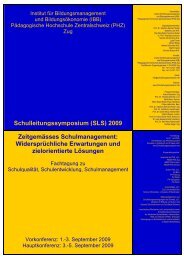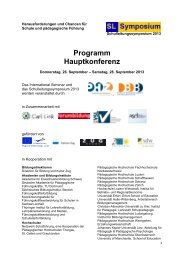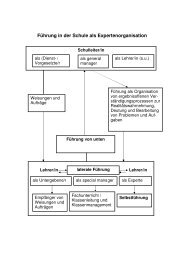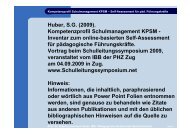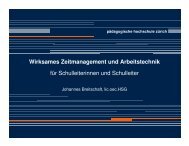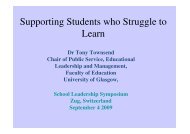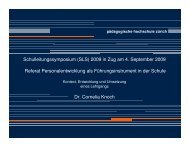The School Environment in the Effective and Ineffective Schools ...
The School Environment in the Effective and Ineffective Schools ...
The School Environment in the Effective and Ineffective Schools ...
Create successful ePaper yourself
Turn your PDF publications into a flip-book with our unique Google optimized e-Paper software.
<strong>The</strong> <strong>School</strong> <strong>Environment</strong> <strong>in</strong> <strong>the</strong><br />
<strong>Effective</strong> <strong>and</strong> <strong>Ineffective</strong> <strong>School</strong>s:<br />
Pr<strong>in</strong>cipals' Perspectives<br />
Shwu-yong L. Huang<br />
Wuu-Liang Huang<br />
National Taiwan University<br />
SLS, September 4, 2009<br />
1
<strong>The</strong> pr<strong>in</strong>cipal <strong>and</strong> <strong>the</strong> <strong>School</strong><br />
<br />
Educational leadership<br />
People centered <strong>and</strong> achievement<br />
oriented<br />
Creat<strong>in</strong>g dist<strong>in</strong>ctive learn<strong>in</strong>g environments<br />
that predict teacher retention <strong>and</strong> school<br />
effectiveness (Brown & Wynn, 2007)<br />
2
<strong>The</strong>oretical Foundation of<br />
Field <strong>The</strong>ory:<br />
<strong>School</strong> <strong>Environment</strong><br />
Human behavior is <strong>the</strong> function of both <strong>the</strong><br />
person <strong>and</strong> <strong>the</strong> environment. (Lew<strong>in</strong>, 1936).<br />
B = f (P, E).<br />
Leadership = f (pr<strong>in</strong>cipal’s s traits, <strong>the</strong> school<br />
environment)<br />
Two approaches:<br />
*Observation vs. perceptions*<br />
3
Conceptual Framework<br />
<br />
<br />
<strong>The</strong> study adopts Moos’ three dimensions model<br />
<strong>in</strong> Work <strong>Environment</strong> Scale (1981) :<br />
(a) <strong>the</strong> Personal Growth,<br />
(b) <strong>the</strong> Relationship, <strong>and</strong><br />
(c) <strong>the</strong> System Ma<strong>in</strong>tenance <strong>and</strong> Change .<br />
<strong>The</strong> criteria for <strong>the</strong> classification of effective <strong>and</strong><br />
<strong>in</strong>effective schools :<br />
(a) <strong>the</strong> rat<strong>in</strong>g of schools by education experts, &<br />
(b) st<strong>and</strong>ardized test scores.<br />
4
A <strong>School</strong> <strong>Environment</strong> Model<br />
<strong>Effective</strong><br />
schools<br />
Subjects -<br />
pr<strong>in</strong>cipals<br />
<strong>Ineffective</strong><br />
schools<br />
Student Academic<br />
Orientation<br />
<strong>School</strong> St<strong>and</strong>ards<br />
Pr<strong>in</strong>cipal Leadership<br />
Teacher-Student<br />
Relations<br />
Teacher Affiliation<br />
Teacher-Parent<br />
Relations<br />
Participatory Decision<br />
Mak<strong>in</strong>g<br />
Curriculum Innovation<br />
Facilities/<br />
Resources/Security<br />
Change <strong>in</strong> <strong>School</strong><br />
Organizational Structure<br />
1. Educational<br />
Implications<br />
2. Strategies for<br />
Improvement<br />
5
Research Questions<br />
(1) Are <strong>the</strong>re significant differences between<br />
effective <strong>and</strong> <strong>in</strong>effective school<br />
pr<strong>in</strong>cipals’ perceptions of <strong>the</strong>ir school<br />
environments?<br />
(2) Do <strong>the</strong> two pr<strong>in</strong>cipal groups differ <strong>in</strong> <strong>the</strong>ir<br />
support of change <strong>in</strong> school<br />
organizational structures?<br />
(3) What are <strong>the</strong> professional profiles of<br />
<strong>the</strong>se two pr<strong>in</strong>cipal groups?<br />
6
Participants<br />
Methods<br />
22 secondary public school pr<strong>in</strong>cipals <strong>in</strong> Taiwan,<br />
11 each <strong>in</strong> effective <strong>and</strong> <strong>in</strong>effective schools<br />
Instrument:<br />
<strong>School</strong> Level <strong>Environment</strong> Questionnaire for<br />
Pr<strong>in</strong>cipals<br />
10 scales, <strong>and</strong> each item was rated on a 5-po<strong>in</strong>t 5<br />
Likert-type type measure<br />
7
Table 1. Descriptions of <strong>the</strong> SLEQP Scales, Moos<br />
Descriptions of <strong>the</strong> SLEQP Scales, Moos’<br />
Dimensions, <strong>and</strong> Sample Items (1)<br />
Scale<br />
Student<br />
Academic<br />
Orientation (P)<br />
<strong>School</strong><br />
St<strong>and</strong>ards (P)<br />
Pr<strong>in</strong>cipal<br />
Leadership (P)<br />
Description<br />
Students are <strong>in</strong>terested<br />
<strong>in</strong> learn<strong>in</strong>g <strong>and</strong> work<strong>in</strong>g<br />
hard.<br />
<strong>The</strong> school has realistic<br />
st<strong>and</strong>ards <strong>and</strong> high<br />
priority <strong>in</strong> learn<strong>in</strong>g.<br />
<strong>The</strong> pr<strong>in</strong>cipal motivates<br />
teachers <strong>and</strong> lets <strong>the</strong>m<br />
know what is expected<br />
of <strong>the</strong>m.<br />
Sample item<br />
Students are<br />
<strong>in</strong>terested <strong>in</strong> learn<strong>in</strong>g<br />
new th<strong>in</strong>gs (+) .<br />
<strong>The</strong> school places a<br />
high priority <strong>in</strong><br />
learn<strong>in</strong>g (+) .<br />
I try to motivate<br />
teachers to work to<br />
<strong>the</strong>ir full capacity (+) .<br />
8
Table 1. Descriptions of <strong>the</strong> SLEQP Scales, Moos’<br />
Dimensions, <strong>and</strong> Sample Items (2)<br />
Scale<br />
Teacher-<br />
Parent<br />
Relations<br />
Teacher-<br />
Student<br />
Relations (R)<br />
Teacher<br />
Affiliation (R)<br />
(R)<br />
Participatory<br />
Decision<br />
Mak<strong>in</strong>g (S)<br />
Description<br />
Teachers get along well<br />
with students, show<br />
<strong>in</strong>terest <strong>and</strong> make students<br />
feel important .<br />
Teachers encourage <strong>and</strong><br />
accept each o<strong>the</strong>r.<br />
Teachers <strong>in</strong>form parents<br />
<strong>and</strong> th<strong>in</strong>k of parents as<br />
partners <strong>in</strong> educat<strong>in</strong>g<br />
children.<br />
Teachers are often asked<br />
to participate <strong>in</strong><br />
adm<strong>in</strong>istrative decisions<br />
<strong>and</strong> work<br />
Sample item<br />
Students get along well<br />
with teachers (+) .<br />
Teachers feel accepted<br />
by o<strong>the</strong>r teachers (+) .<br />
Teachers notify parents<br />
promptly about problems<br />
<strong>and</strong> needs of <strong>the</strong> student<br />
(+) .<br />
Teachers have very little<br />
to say <strong>in</strong> runn<strong>in</strong>g<br />
schools (-(<br />
).<br />
9
Table 1. Descriptions of <strong>the</strong> SLEQP Scales, Moos’<br />
Dimensions, <strong>and</strong> Sample Items (3)<br />
Scale<br />
Curriculum<br />
Innovation (S)<br />
Facilities /<br />
Resources /<br />
Security (S)<br />
Change <strong>in</strong><br />
<strong>School</strong><br />
Organizational<br />
Structure (S)<br />
Description<br />
Creativity <strong>and</strong> <strong>in</strong>novation are<br />
encouraged <strong>and</strong> new courses<br />
implemented .<br />
<strong>The</strong> school is safe <strong>and</strong> its<br />
facilities <strong>and</strong> resources are<br />
adequate<br />
<strong>The</strong> school evaluates<br />
programs <strong>and</strong> opens to<br />
parent or student<br />
suggestions; school staff is<br />
effective <strong>in</strong> <strong>in</strong>troduc<strong>in</strong>g<br />
changes or propos<strong>in</strong>g<br />
improvement.<br />
Sample item<br />
Teachers are<br />
encouraged to be<br />
<strong>in</strong>novative <strong>in</strong> this<br />
school (+) .<br />
Students usually feel<br />
safe <strong>in</strong> <strong>the</strong> school (+) .<br />
Our adm<strong>in</strong>istrators <strong>and</strong><br />
teachers are open to<br />
student or parent<br />
suggestions (+) .<br />
10
Table 2. Pr<strong>in</strong>cipals' Perceptions of <strong>The</strong>ir <strong>School</strong> <strong>Environment</strong>s <strong>in</strong>i<br />
<strong>Effective</strong> <strong>and</strong> <strong>Ineffective</strong> <strong>School</strong>s<br />
No. of Alpha<br />
Scales items Rel.<br />
<strong>Effective</strong><br />
M SD<br />
<strong>Ineffective</strong><br />
M SD<br />
Effect<br />
size<br />
Student Academic Orientation<br />
3<br />
.64<br />
4.63<br />
0.25<br />
4.13<br />
0.48<br />
1.31**<br />
<strong>School</strong> St<strong>and</strong>ards<br />
3<br />
.69<br />
4.60<br />
1.00<br />
4.08<br />
0.32<br />
0.70*<br />
Pr<strong>in</strong>cipal Leadership<br />
3<br />
.70<br />
4.67<br />
0.47<br />
4.25<br />
0.32<br />
1.04**<br />
Teacher-Student Relations<br />
3<br />
.86<br />
4.67<br />
0.47<br />
4.17<br />
0.33<br />
1.23**<br />
Teacher Affiliation<br />
3<br />
.84<br />
4.50<br />
0.64<br />
3.83<br />
1.11<br />
0.74*<br />
Teacher-Parent Relations<br />
3<br />
.89<br />
4.25<br />
0.57<br />
3.42<br />
0.96<br />
1.05**<br />
Participatory Decision Mak<strong>in</strong>g<br />
3<br />
.68<br />
4.17<br />
0.92<br />
3.50<br />
0.84<br />
0.76*<br />
Curriculum Innovation<br />
3<br />
.84<br />
4.42<br />
0.57<br />
4.25<br />
0.57<br />
0.30<br />
Facilities/ Resources/Security<br />
3<br />
.70<br />
4.50<br />
0.33<br />
4.25<br />
0.74<br />
0.44<br />
Change <strong>in</strong> <strong>School</strong><br />
Organizational Structure<br />
5<br />
.95<br />
3.60<br />
1.60<br />
3.90<br />
0.26<br />
-0.26<br />
* Effect size > 0.50. ** Effect size > 0.80.<br />
11
Figure 1. Pr<strong>in</strong>cipals' Perceptions of <strong>The</strong>ir <strong>School</strong> <strong>Environment</strong>s <strong>in</strong> i<br />
<strong>Effective</strong> <strong>and</strong> <strong>Ineffective</strong> <strong>School</strong>s<br />
5<br />
12<br />
4<br />
3<br />
2<br />
<strong>Effective</strong> school pr<strong>in</strong>cipals<br />
1<br />
<strong>Ineffective</strong> school pr<strong>in</strong>cipals<br />
0<br />
Student Academic Orientation<br />
<strong>School</strong> St<strong>and</strong>ards<br />
Pr<strong>in</strong>cipal Leadership<br />
Teacher-Student Relations<br />
Teacher Affiliation<br />
Teacher-Parent Relations<br />
Participatory Decision Mak<strong>in</strong>g<br />
Curriculum Innovation<br />
Facilities/ Resources/ Security<br />
Change <strong>in</strong> <strong>School</strong> Organization Stucture
Discussion<br />
<strong>The</strong> study identifies school environment variables that<br />
differentiate effective <strong>and</strong> <strong>in</strong>effective schools :<br />
<strong>Effective</strong> school pr<strong>in</strong>cipals ><br />
<strong>Ineffective</strong> school pr<strong>in</strong>cipals<br />
1. teacher <strong>in</strong>terpersonal relations with students,<br />
colleagues, <strong>and</strong> parents,<br />
2. students academic orientation <strong>and</strong> school<br />
st<strong>and</strong>ards,<br />
3. confidence <strong>in</strong> <strong>the</strong>ir leadership,<br />
4. teachers participate <strong>in</strong> decision mak<strong>in</strong>g,<br />
13
<strong>The</strong> Pr<strong>in</strong>cipal profile<br />
<strong>Effective</strong> school pr<strong>in</strong>cipals ><br />
<strong>Ineffective</strong> school pr<strong>in</strong>cipals :<br />
hav<strong>in</strong>g longer experience <strong>in</strong> teach<strong>in</strong>g,<br />
serv<strong>in</strong>g longer as a pr<strong>in</strong>cipal at <strong>the</strong><br />
current school, <strong>and</strong><br />
report<strong>in</strong>g greater <strong>in</strong>tention to<br />
cont<strong>in</strong>ue as a pr<strong>in</strong>cipal for ano<strong>the</strong>r<br />
term.<br />
14
Implications for <strong>School</strong> <strong>Effective</strong>ness<br />
Pr<strong>in</strong>cipal’s s perceptions of school environments reflect school<br />
effectiveness.<br />
<br />
<br />
<br />
As effective school pr<strong>in</strong>cipals had stronger professional<br />
As effective school pr<strong>in</strong>cipals had<br />
background, , strategies <strong>and</strong> policies may be developed to<br />
enhance pr<strong>in</strong>cipals professional competency.<br />
leadership<br />
<strong>Effective</strong> school pr<strong>in</strong>cipals demonstrated certa<strong>in</strong> leadership<br />
traits like promot<strong>in</strong>g collaborative decisions, <strong>and</strong> sett<strong>in</strong>g high<br />
school st<strong>and</strong>ards. Pr<strong>in</strong>cipal preparation programs must<br />
develop <strong>the</strong>se leadership traits.<br />
<strong>The</strong> feedback helps pr<strong>in</strong>cipals to underst<strong>and</strong> better <strong>the</strong><br />
strengths <strong>and</strong> weakness of <strong>the</strong>ir school environment, <strong>and</strong><br />
reflect on <strong>the</strong>ir own leadership style for improvement.<br />
15
Educational Implications<br />
<strong>The</strong>ory & Policy --<br />
Add to <strong>the</strong> goodness-of<br />
of-fit fit of pr<strong>in</strong>cipals <strong>and</strong><br />
school environments.<br />
Practice --<br />
Identify trait of effective leaders to guide<br />
improvements <strong>in</strong> pr<strong>in</strong>cipal preparation programs.<br />
Future Research --<br />
Increase participants <strong>and</strong> add qualitative data.<br />
Explore o<strong>the</strong>r factors associated with pr<strong>in</strong>cipals’<br />
perceptions of <strong>the</strong> school environment.<br />
16
Thank you for your attention<br />
17



